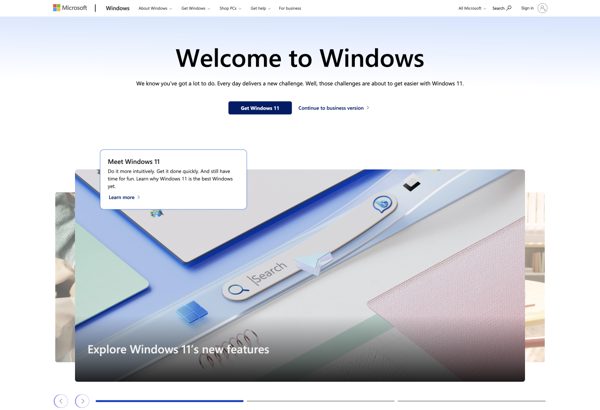Clear Linux
Clear Linux is an open-source Linux distribution optimized for performance and security. It is developed by Intel for cloud, edge, and IoT use cases. Clear Linux uses a rolling-release model with continuous delivery of software updates and focuses on a minimal set of packages.

Clear Linux: Optimized Performance and Security
Open-source Linux distribution for cloud, edge, and IoT use cases, featuring rolling-release model and continuous software updates
What is Clear Linux?
Clear Linux is an open-source Linux distribution optimized for performance, security, and simplicity. It is developed by Intel primarily for cloud computing and edge computing use cases. Some key features of Clear Linux include:
- Rolling-release model - Clear Linux uses a rolling release method of updates, with continuous delivery instead of point releases. This allows it to incorporate new features and updates rapidly.
- Performance optimizations - Clear Linux incorporates various performance tuning options out-of-the-box for improved speed and responsiveness. This includes optimizing compilers, libraries, kernel configuration, and more.
- Enhanced security - Security features like address space layout randomization (ASLR), Kernel Page Table Isolation, and secure boot are enabled by default.
- Minimal set of packages - Clear Linux focuses on a minimal core set of packages needed to boot and run. This improves security, reduces maintainence overhead, and allows optimizations.
- Designed for containers and cloud-native infrastructure - Clear Linux is designed as a host OS for running containerized workloads optimally.
So in summary, Clear Linux aims to deliver a simple, optimized, rolling-release Linux distribution focusing on performance, security,containers and cloud/edge computing use cases.
Clear Linux Features
Features
- Optimized for performance and speed
- Minimal set of packages for smaller footprint
- Rolling release model for continuous updates
- Built-in support for containers
- Focused on security
- Supports a wide range of hardware architectures
Pricing
- Open Source
Pros
Very fast boot times
Highly optimized for performance
Small OS footprint
Easy to update and maintain
Enhanced security features
Cons
Limited hardware support
Smaller package repository
Less user-friendly for beginners
Targeted at specific use cases
Official Links
Reviews & Ratings
Login to ReviewThe Best Clear Linux Alternatives
Top Os & Utilities and Linux Distributions and other similar apps like Clear Linux
Here are some alternatives to Clear Linux:
Suggest an alternative ❐Windows 10
Windows 10 is the latest version of Microsoft's operating system, released in 2015. It builds on the core foundations of Windows 7 and 8 and brings back the familiar Start menu while also introducing new features.Some key new features and improvements in Windows 10 include:The return of the Start Menu...

Ubuntu
Ubuntu is one of the most popular Linux distributions available today. It is based on Debian and completely free and open source. Some key points about Ubuntu:It has an easy to use and intuitive interface, making it great for Linux beginners.It has a wide variety of official flavors featuring different...

MacOS
macOS is the operating system created and developed by Apple Inc. exclusively for its Macintosh computers and laptops. It was originally named Mac OS X until 2012 and then OS X until 2016, when Apple renamed it to macOS to bring it inline with the branding of its other operating...

Linux Mint
Linux Mint is a Linux distribution built on top of Ubuntu that aims to provide a more complete out-of-the-box experience. Some key aspects of Linux Mint include:User-friendly desktop environment with a familiar workflow for Windows usersComes with a lot of pre-installed software for common tasks like office productivity, internet browsing,...

Windows 7
Windows 7 is a personal computer operating system that was produced by Microsoft as part of the Windows NT family of operating systems. It was released to manufacturing in July 2009 and became generally available in October 2009 as the successor to Windows Vista.Some of the key features and improvements...

Elementary OS
elementary OS is a Linux distribution based on Ubuntu that focuses on providing a fast, open, and privacy-respecting computing experience. It comes with a custom desktop environment called Pantheon that features a sleek and intuitive user interface designed for productivity.Some key features of elementary OS include:An app store called AppCenter...

Debian
Debian is one of the oldest and most popular Linux distributions available today. First released in 1993, it is known for its stability, commitment to free software principles, and huge repository of over 50,000 software packages.Some key facts about Debian:It is developed by a worldwide community of volunteers working together...

Fedora
Fedora is a Linux distribution developed by the Fedora Project and sponsored by Red Hat. It is one of the most popular community-driven Linux distributions and is known for showcasing the latest innovations in open source software on a stable and easy-to-manage platform.Some key features of Fedora include:Uses the RPM...

Manjaro Linux
Manjaro Linux is an open source, independently developed GNU/Linux distribution based on Arch Linux. It aims to provide an accessible entry point for new Linux users, while maintaining the DIY spirit and technical simplicity that Arch Linux is known for.Some key features of Manjaro Linux include:User-friendly graphical installers for quick...

OpenSUSE
openSUSE is a versatile Linux distribution that can be used on desktops, laptops, and servers. It focuses on being easy to use, having up-to-date software packages, and providing flexibility for different types of users.Some key features and information about openSUSE:Sponsored by SUSE Linux and other companies, but community-developedRegular release cycle...

Kubuntu
Kubuntu is an officially recognized flavor of the Ubuntu Linux distribution that features the KDE Plasma desktop environment instead of Ubuntu's default GNOME desktop. Kubuntu provides a user-friendly, customizable, and visually appealing desktop experience powered by the latest KDE Plasma technologies.Some key features and characteristics of Kubuntu include:Uses the lightweight...

Windows 10 Enterprise LTSC
Windows 10 Enterprise LTSC (Long-Term Servicing Channel) is a specialized version of Windows 10 Enterprise designed for devices that require maximum stability and compatibility over long periods of time. It provides 10 years of mainstream support and security updates without any feature updates.LTSC versions are ideal for machines controlling medical...
